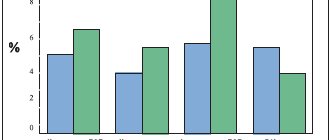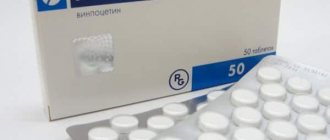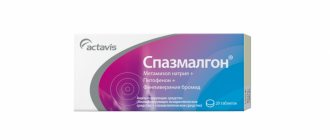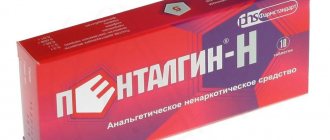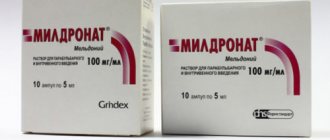We all need protection to one degree or another. External and internal. The body and mind are quite fragile and can be strengthened and supported in different ways. Even with medication.
If a person experiences negative effects (stress, shock, ischemia, intoxication, cerebrovascular accident, etc.), then the doctor may prescribe Mexidol.
Mexidol is a good helper in the fight against stress
Operating principle
The drug belongs to the group of heteroaromatic antioxidants and basically contains ethylmethylhydroxypyridine succinate, which in turn protects cell membrane lipids and reduces the level of free radicals in the body. This significantly expands the spectrum of pharmacological action. Mexidol has an antihypoxic (saturates the blood with oxygen), anti-stress, anticonvulsant effect. It also has nootropic properties, prevents and reduces memory impairment, increases concentration and performance, and reduces the manifestation of alcohol intoxication. Restores the sleep-wake cycle, improves the metabolism of brain tissue and their blood supply, improves microcirculation and rheological properties of blood (its fluidity), reduces the rate of dystrophic and morphological changes in the brain. It has a pronounced therapeutic effect in the treatment of Parkinson's disease. Mexidol improves the functional state of ischemic myocardium and the adaptive capabilities of the human body when exposed to various stress factors.
Mexidol also increases the content of dopamine, the so-called “hormone of joy”, in the brain.
Mexidol increases or decreases blood pressure
Mexidol indirectly affects blood pressure. The result of using the drug depends on the characteristics of the disease and the patient’s body. Mexidol belongs to a group of drugs that have a complex effect on the body, improving the functioning of all internal organs. It is thanks to this action that normalization of pressure occurs.
The drug is effective with minor deviations from the norm, and the effect can be both downward and upward.
Therefore, treatment with Mexidol begins with small doses, adjusting the amount of the drug depending on the effect obtained.
With an increased level of pressure, negative processes occur in the patient’s body, resulting in significant oxygen starvation. The hypoxic state causes a sharp deterioration in health and malaise. With high blood pressure, Mexidol improves blood flow, which helps stabilize the situation.
In case of arterial hypotension, Mexidol should be taken with caution, as the drug can lower blood pressure. For problems with blood pressure, drug therapy can provide significant improvement, but the length and duration of medication should be determined by the attending physician. It is worth remembering that the drug for low or high blood pressure should complement traditional treatment, and not be a complete replacement for antihypertensive drugs.
Indications
In neurology, Mexidol is used in the following cases:
- acute cerebral circulatory disorders and discirculatory encephalopathy (otherwise – cerebral atherosclerosis);
- after transient ischemic attacks, in the subcompensation phase as preventive courses;
- vegetative-vascular dystonia;
- cognitive problems of atherosclerotic origin (impaired speech, memory, attention, intelligence and other symptoms associated with the development of atherosclerosis).
In psychiatry Mexidol is prescribed:
- to relieve withdrawal symptoms (otherwise known as withdrawal) due to alcohol and drug addiction;
- in case of intoxication with neuroleptics (drugs intended for the treatment of psychosis);
- to alleviate the impact of extreme (stress) factors;
- for anxiety disorders and neurotic and neurosis-like conditions.
Mexidol is also used for acute purulent-inflammatory processes of the peritoneum (necrotizing pancreatitis and peritonitis) as part of a complex of therapeutic treatments.
Instructions for use "Mexidol"
Tablets are taken 1 pc. 2 times a day. This is the minimum dose with which to start treatment. If there are no allergic reactions or other side effects, the dosage can be increased to 4-6 tablets per day. Those. in the future you can take 1-2 tablets maximum 3 times a day.
The total duration of therapy is determined by the disease:
- hangover – 5-7 days;
- drug addiction – 5-7 days;
- ischemia – up to 60 days.
Side effects
One of the side effects after taking Mexidol may be nausea
Despite the body’s positive reaction to taking Mexidol and its low toxicity, the medicine still has side effects.
- from the cardiovascular system: increased blood pressure, decreased blood pressure;
- from the nervous system: drowsiness, difficulty falling asleep, anxiety, emotional reactivity, headache, loss of coordination;
- from the gastrointestinal tract: nausea, dry mouth;
- from the immune system: allergic reactions, including hyperemia, skin rash, itching;
- others: distal hyperhidrosis.
The effect of Mexidol on blood pressure
The drug is often prescribed to normalize blood pressure. It is often used for hypotension and hypertension.
The positive effect on low and high blood pressure is due to the following effects:
- changes the composition of the blood and improves its blood flow, which helps accelerate blood circulation;
- has a strong antioxidant and anxiolytic effect;
- reduces the level of intoxication;
- cell membranes have a positive effect, functional performance is restored;
- Oxidative processes slow down;
- Reduces the content of “bad” cholesterol;
- Helps with neuroses.
Taking the drug improves the activity of neurotransmitters, which are responsible in the body for the quality of transmission of nerve impulses to brain cells. As a result of taking the drug, a person with hypertension experiences a general improvement in well-being, which is ensured by the resumption of metabolic processes and improved nutrition of internal organs. Stress is a common cause of high blood pressure. The effect of the drug reduces anxiety and relieves emotional discomfort, thereby normalizing blood pressure.
The ability to improve sleep quality and reduce psychomotor agitation also has a beneficial effect on blood pressure.
The properties of Mexidol make it possible to influence the mechanisms of formation of various types of diseases, leading to their inhibition and initiating the resumption of the body's defense reactions at the biochemical level. At the same time, the drug has a minimal number of side effects compared to drug analogues.
How to take Mexidol?
Mexidol in tablet form is taken orally. The tablet is not chewed or divided in half. You should drink it with plenty of water. Eating does not have any effect on the activity of the medication, so you can take Mexidol before, during or after meals.
The injection form is used for intramuscular injections or intravenous infusions (stream or drip). Before giving the injection, the drug is diluted in a 0.9% sodium chloride solution. It is injected slowly in a stream over 5 - 7 minutes, drip - at a rate of 40 - 60 drops per minute. The maximum daily dose for tablets is 800 mg, for injections - 1200 mg. Course therapy is canceled gradually, after achieving a stable clinical and laboratory effect.
Mexidol solution for intravenous administration
Please note that drowsiness may occur after taking Mexidol, so you should be careful while driving, as well as when engaging in other potentially dangerous activities.
| Disease | Course duration | Dosage* |
| Acute cerebrovascular accident (ACVA) | Initially within 10-14 days | 200-500 mg (i.v. drip) 2 to 4 times/day, then for another 14 days 200-250 mg (i.m.) several times/day |
| Encephalopathy | Initially within 2 weeks | See ONMK |
| Mild cognitive impairment | Course from 2 weeks to a month | 100-300 mg/day (i.m.) |
| Withdrawal syndrome | 5 to 7 days | 200-250 mg/day (iv drip or intramuscular injection) 2 - 3 times/day |
| Antipsychotic drug poisoning | Course in 7-14 days | From 200 to 500 mg/day (iv) |
| Acute edematous (interstitial) pancreatitis | 200-500 mg (iv drip and intramuscular injection) 3 times a day | |
| Necrotizing pancreatitis (mild) | 100-300 mg/day (iv drip and intramuscular injection 3 times/day | |
| Necrotizing pancreatitis (moderate) | 200 mg (iv) 3 times/day | |
| Necrotizing pancreatitis (severe) | In a pulse dosage of 800 mg on the first day, with a double dose regimen. Then 200 - 500 mg 2 times a day with a gradual reduction in the daily dose. | |
| Necrotizing pancreatitis (extremely severe) | From 800 mg/day to relieve shock. Next, 300 - 500 mg (iv drip) 2 times a day with a gradual reduction in the daily dosage. | |
| Open-angle glaucoma of various stages | Course 14 days | IM 100 - 300 mg/day, 1 - 3 times/day |
| Traumatic brain injury and consequences of traumatic brain injury | Within 10 -15 days | IV drip 200 - 500 mg 2 - 4 times / day |
*When taking pills. The method of administering the Mexidol injection in the same dosage is indicated in parentheses.
The duration of therapy for patients with coronary heart disease is at least 1.5-2 months. It is advisable to carry out repeated courses (on the recommendation of a doctor) in the spring and autumn.
In case of acute myocardial infarction, as part of complex therapy, it is administered intravenously (the first 5 days) and intramuscularly (the next 9 days) for 14 days against the background of traditional therapy for myocardial infarction, including nitrates, beta-blockers, angiotensin-converting enzyme (ACE) inhibitors, thrombolytics, anticoagulants and antiplatelet agents, as well as symptomatic agents according to indications.
Mexidol (2-ethyl-6-methyl-3-hydroxypyridine succinate) is a domestic original antioxidant and antihypoxant, created at the Research Institute of Pharmacology of the Russian Academy of Medical Sciences in the mid-80s.
Mexidol consists of two related and functionally significant compounds: 2-ethyl-6-methyl-3-hydroxypyridine and succinic acid. The presence of 3-hydroxypyridine in the structure of Mexidol provides a complex of its antioxidant and membranotropic effects, the ability to reduce glutamate excitotoxicity, and modulate the functioning of receptors, which fundamentally distinguishes Mexidol from other drugs containing succinic acid. The presence of succinate in the structure of Mexidol distinguishes it from emoxipine and other 3-hydroxypyridine derivatives, since succinate is functionally significant for many processes occurring in the body and, in particular, is a substrate for increasing energy metabolism in the cell.
The combination of two compounds with the necessary properties in the structure of Mexidol ensures its good permeability through the blood-brain barrier (BBB), high bioavailability and action on various targets, resulting in a wide range of effects of the drug and high therapeutic potential.
Mexidol is a drug with a multicomponent, multi-target mechanism of action. In this case, its main mechanisms are: antioxidant and membranotropic effects, the ability to reduce glutamate excitotoxicity, modulate the functioning of receptors and membrane-bound enzymes, restore neurotransmitter balance, and increase the energy status of the cell [13, 15, 18, 22, 27, 38]. Through these mechanisms, influencing a set of chemical and physical processes and ensuring the necessary coupling of its main elements (receptors, ion channels, enzymes, etc.), Mexidol is able to influence the functioning of cellular structures associated with the transmission of information and the development of various pathological conditions. An important component of the mechanism of action of Mexidol is also its ability to influence free radical processes, which are one of the basic processes involved in the modifying/damaging effect on the cellular structures of the central nervous system and other organs and tissues.
Among the known antioxidants, Mexidol occupies a special position, since it affects various parts of free radical processes in biomembranes and inside the cell and does not have a pro-oxidant effect, which under certain conditions is characteristic of many other antioxidants [38].
On the one hand, Mexidol inhibits the processes of lipid peroxidation (LPO) and actively reacts with primary and hydroxyl radicals of peptides; reduces the level of NO in the brain increased in pathology, and on the other hand, increases the activity of antioxidant enzymes, in particular superoxide dismutase (SOD) and glutathione peroxidase, responsible for the formation and consumption of lipid peroxides, as well as reactive oxygen species [7, 13, 15, 22, 24 , 25, 30, 35, 36, 42, 46].
In its antioxidant activity, Mexidol is superior to emoxipin and proxipin [30, 36].
Foreign enzymatic antioxidants created on the basis of SOD isolated from natural material (ontosein, oxodrol, peroxinorm) have significant disadvantages: they are unstable, quickly inactivated and have many side effects. Mexidol, which causes activation of endogenous SOD, is free of these disadvantages and, thus, has significant advantages over enzymatic antioxidants of natural origin.
Thus, Mexidol is a universal means of antioxidant pharmacotherapy, since it affects various parts of oxidative stress: it inhibits free radical oxidation of lipids in biomembranes, actively reacts with lipid peroxide radicals, primary and hydroxyl radicals of peptides, reduces the level of NO, increases the activity of SOD and other antioxidant enzymes.
Due to its mechanism of action, Mexidol has a wide range of pharmacological effects, realized at least at two levels - neuronal and vascular. It has neuroprotective, antihypoxic, antiischemic, nootropic, vegetotropic, antistress, anxiolytic, anticonvulsant and other effects. Under the influence of Mexidol, an improvement in cerebral circulation and microcirculation is observed.
The therapeutic effect of Mexidol is dose-dependent. As the dose is increased to a certain level, an increase in effect is usually observed. The range of therapeutic doses of Mexidol is quite wide and in experiments ranges from 10 to 300 mg/kg. With an increase in the dose of Mexidol, the latent period of onset decreases and the severity and duration of the effect increases.
Mexidol has the most pronounced effect in the treatment of vascular and neurodegenerative diseases, primarily acute and chronic cerebrovascular accidents, including strokes. It can be distinguished as one of the most effective drugs used in the treatment of these forms of pathology. Thanks to its mechanism of action, Mexidol influences the key basic links in the pathogenesis and other diseases associated with neurodegeneration processes, such as Alzheimer’s and Parkinson’s diseases, brain injuries, convulsions, stress, etc. [47].
Mexidol has a clear therapeutic effect in cerebral ischemia, which occurs when systemic hemodynamics is disrupted, with changes in blood vessels leading to metabolic reactions, when in the ischemic zone the concentration of LPO substrates and the generation of reactive oxygen species increase, pro-oxidants (LPO stimulants) accumulate, and activity decreases antioxidant enzymes. The drug enters ischemic cells, and under its influence, a decrease in the area of brain damage during a stroke is observed (morphological studies), the percentage of animals surviving after a stroke sharply increases, the functional activity of the brain is restored, which is expressed in the improvement of cognitive functions, indicators of neurological deficit and psycho-emotional state [12 , 19, 33, 35, 41]. It is Mexidol's powerful antioxidant effect that makes it preferable to drugs containing succinic acid and not having antioxidant properties.
It was found [14, 33] that Mexidol has the ability to increase life expectancy and the number of surviving animals under various hypoxic conditions: hypobaric hypoxia, hypoxia with hypercapnia in a hermetic volume and hemic hypoxia. For example, in conditions of acute hypobaric hypoxia, when animals rise to a height of 11,000 meters, Mexidol after its injection increases their life expectancy by 2 times, and the number of surviving animals by 2.4 times. In terms of antihypoxic activity, Mexidol is significantly superior to pyritinol and piracetam, which have weak antihypoxic activity under conditions of acute hypobaric hypoxia and hypoxia with hypercapnia.
The mechanism of the antihypoxic action of Mexidol is also associated with its specific effect on energy metabolism, which is due to the succinate succinate included in its composition, which, under hypoxic conditions, entering the intracellular space, is capable of being oxidized by the respiratory chain. Succinic acid provides increased compensatory activation of aerobic glycolysis and decreased inhibition of oxidative processes in the Krebs cycle, which leads, under hypoxic conditions, to an increase in the content of ATP and creatine phosphate, activation of the energy-synthesizing functions of mitochondria, and stabilization of cell membranes. Mexidol is an antihypoxant with a direct energizing effect, the effect of which is associated with the influence on the endogenous respiration of mitochondria, activation of the energy-synthesizing function of mitochondria with the activation of compensatory metabolic flows that supply energy substrates to the respiratory chain, in this case succinate, and acting as an urgent adaptation mechanism during hypoxia [26, 27, 39].
It is known that with traumatic brain injury there is an intensification of lipid peroxidation processes both in the blood and in brain tissue, and there is a decrease in the oxidative and phosphorylating function of mitochondria. In this case, Mexidol, eliminating the excessive activity of free radical oxidation processes in the dynamics of the post-traumatic period, has a protective effect on bioenergetic processes in the brain during traumatic brain injury by changing the functional state of the mitochondrial respiratory chain [30].
It has been established that Mexidol has a pronounced and optimal antioxidant, hypolipidemic, hypoglycemic, hepatoprotective effect compared to Actovegin and Infezol in conditions of alloxan hyperglycemia, cholesterol dyslipidemia and alloxan-cholesterol dyslipidemia [36, 37]. It has a pronounced preventive effect on the dynamics of metabolic parameters in conditions of a combination of lipid and carbohydrate metabolism disorders in the experiment and is superior in this effect to emoxypine, dimephosphone and alpha-tocopherol, providing a hypoglycemic, hypolipidemic effect. Mexidol prevents disturbances in protein metabolism and the development of cytolytic syndrome, providing an antioxidant effect recorded in blood serum, and reducing the growth of markers of electrical instability of the myocardium, restoring the level of malondialdehyde and catalase activity to intact values in the myocardium, liver and kidneys of experimental animals [36].
The most important link in the mechanism leading to cell death is the occurrence of glutamate excitotoxicity, which is observed in various forms of neurodegeneration and is characterized by increased release of glutamate from neuron terminals into the intercellular space. In particular, during a stroke, this release occurs in the lesion and is then observed to diffuse into the ischemic penumbra zone. Glutamate excitotoxicity leads to cell death, which is called “death by overexcitation.” Excessive accumulation of glutamate activates the ionotropic NMDA and AMPA subtypes of glutamate receptors, causing a massive influx and shock increase in Ca2+ ions in the postsynaptic neuron cell. Calcium in the cell triggers activation of the mitochondrial respiratory chain with increased leakage of superoxide anion radical and hydroxyl radical; activation of NADPH2 oxidase, resulting in an increase in the content of superoxide anion radical; activation of NO synthase (NOS) occurs, which leads to the accumulation of NO; activation of heme oxygenase, which converts Fe3+ to Fe2+. All of the above processes intensify LPO, and in response, the cell’s AOS defense system is activated. With prolonged hypoxia, its depletion is observed, which leads to the development of oxidative stress and death of nerve cells through apoptosis or necrosis, depending on the degree of their damage [4, 20]. in vitro studies
on transverse experiencing sections of the hippocampus, it was established that Mexidol at a concentration of 4 mM suppresses orthodromic population responses in the CA1 field, and the non-competitive antagonist of the glutamate NMDA receptor MK-801 weakens the inhibitory effect of Mexidol, while a specific blocker of glutamate AMPA receptors does not affect the effects of Mexidol [28].
Using the methods of microiontophoresis and pneumomicroinjection when Mexidol is applied to individual neurons, it was found that it has a direct effect on the majority of neurons in the sensorimotor cortex of the brain of awake animals, causing both inhibitory and excitatory reactions [28]. Mexidol has a pronounced ability to improve learning and memory processes, has a clear anti-amnestic effect, eliminating memory impairment caused by various influences [9, 13, 22, 46, 47]. The experiment showed that Mexidol effectively eliminates amnesia of the conditioned passive avoidance reflex in rats caused by such harsh influences as administering a maximum electric shock immediately after training, administering the anticholinergic scopolamine or after deprivation of the paradoxical sleep phase. In terms of anti-amnestic action, Mexidol is not inferior, and in some cases superior in activity and depth of effect, to such nootropic drugs as piracetam, pyritinol, meclofenoxate, cleregil, pantogam, picamilon, sodium hydroxybutyrate [8, 22, 46].
Along with the anti-amnestic effect, Mexidol promotes the preservation of a memory trace and counteracts the process of extinction of acquired/acquired skills and reflexes.
Mexidol has a positive restorative effect on impaired cognitive functions that occur during natural aging and in experimental models of Alzheimer's and Parkinson's diseases [8, 11, 25, 43, 45, 47]. Along with improving learning and memory processes in old animals, under the influence of Mexidol, some manifestations of neurological deficits are eliminated, emotional status is restored, and the level of cholesterol, low-density lipoproteins, triglycerides, and lipofuscin is reduced to normal. The mechanism of Mexidol's positive effect on cognitive functions is also associated with its membrane-protective and antioxidant effects. According to the synapse-membrane organization of memory, the decisive role in consolidating information in the central nervous system belongs to conformational shifts of protein macromolecules in the synapse area. Mexidol, having a pronounced effect on the physicochemical properties of the membrane and causing its structural and functional rearrangements, increases the functional activity of the biological membrane and, thus, promotes the formation of stable conformational changes in protein macromolecules of synaptic membranes, the formation of interconnected systems of membrane complexes of neurons, resulting in activation synaptic processes and improvement of cognitive functions. Also important is the ability of Mexidol to change the phospholipid composition of the outer membrane of brain synaptosomes; For memory processes, it seems especially important to increase the content of phosphatidylserine, which affects the activity of potassium and calcium ATPase and phosphotidylinositol, which increases the affinity of the acetylcholine receptor for acetylcholine. In addition, Mexidol has been shown to prevent the development of atheroarteriosclerosis [21].
Mexidol also has a pronounced anxiolytic effect, i.e. the ability to eliminate fear, anxiety, tension, restlessness. In an experiment using the conflict situation technique in rats, it was shown that Mexidol has pronounced anxiolytic activity, increasing the number of punishable water intakes. It has similar activity to diazepam, however, unlike diazepam, after Mexidol the adequacy of the response to provoking test stimuli on the Brodie-Nauth scale is not impaired and no side effects in the form of sedation and muscle relaxation are observed. Mexidol has an effect on various types of stressful situations, for example, stress due to the novelty of the situation, anxiety and fear caused by negative influences previously received in these conditions, stress in anticipation of pain, and in situations of mismatch between what is desired and what is actually done [6, 16]. Analysis of the mechanism of implementation of the anxiolytic effect of Mexidol showed that Mexidol does not have the ability to bind to benzodiazepine and GABA receptors, however, it has the ability to enhance the binding of labeled diazepam to benzodiazepine receptors. Thus, without having direct affinity for benzodiazepine and GABA receptors, Mexidol has a modifying effect on them, enhancing their ability to bind [32, 44].
In the light of modern ideas about substances of a new type that are not related to direct receptor agonists, the effect of Mexidol can be represented as the effect of a modulator, allosterically potentiating the ligand receptor, and an activator of ion channels through the mechanism of membrane-receptor interaction.
The anti-stress, anxiolytic effect is complemented by Mexidol’s unique ability to increase the body’s resistance to various extreme factors, such as stress, conflict situations, electric shock, physical activity, hypoxia, sleep deprivation, and various intoxications [17, 40]. Along with this, Mexidol eliminates disorders that arise from alcoholism and drug addiction [11][], [].
Mexidol has a wide range of anticonvulsant effects [2, 10, 29, 34]. In animal experiments, Mexidol weakens convulsions caused by various influences: corazol, maximum electric shock, strychnine, thiosemicarbazide, bicuculline, picrotoxin, 5-hydroxytryptophan. Mexidol reduces the duration and number of discharges of primary and secondary generalized tonic-clonic seizures in a model of cobalt epilepsy. The mechanism of the anticonvulsant action of Mexidol is determined by its influence on the processes of free radical metabolism, cellular hypoxia and increased action of GABA.
One of the important properties of Mexidol is its ability to improve and potentiate the specific effect of known drugs [7]. It has been shown that when combining Mexidol and phenazepam in doses of a low therapeutic level, an anxiolytic effect of the same severity is achieved as when the dose of phenazepam is increased by 10 times. The potentiating effect of Mexidol was also revealed by its anticonvulsant effect when combined with phenytoin, phenobarbital, valproate and carbamazepine. It has been shown that, by enhancing the main therapeutic effect of drugs, Mexidol reduces their side effects. The combined use of Mexidol with anticonvulsants in the epilepsy clinic made it possible to significantly reduce the doses of basic anticonvulsants and reduce their side effects [1, 3, 34]. The combined use of Mexidol with antihypertensive drugs, in particular with bisogamma, promotes more effective correction of blood pressure and a reduction in the dose of beta-blocker in young patients [5].
Due to the combination of a pyridine base and succinic acid in its structure, Mexidol has a high ability to pass the BBB and bioavailability. It has been established that when administered enterally and parenterally, Mexidol is quickly absorbed and quickly eliminated from the body [23, 31]. A targeted study of the pharmacokinetics of Mexidol was carried out on patients with neurotic disorders undergoing treatment in a hospital (Mexidol was prescribed intramuscularly at 200-250 mg 2 times a day) [23, 31]. Analysis of the parameters of Mexidol, both with a single and course use, showed that its concentration in the blood increases quite quickly, reaching a maximum after an average of 0.58 hours.
At the same time, Mexidol is quickly eliminated from the blood and after 4 hours it is practically not registered, therefore, to maintain a therapeutic concentration, at least 2-fold administration is necessary during the day. The pharmacokinetic profile of the drug with both single and long-term administration does not differ significantly. A study of Mexidol excretion in urine showed that it is excreted both unchanged and in the form of a glucuronoconjugate, which constitutes a significant amount. A correlation analysis of the relationship between the psychopharmacological effect and the kinetic characteristics of Mexidol showed that with an increase in the maximum concentration of Mexidol, the anxiolytic effect of the drug increases [23, 31].
A significant advantage of Mexidol is that it is a low-toxic drug with a large therapeutic breadth, has virtually no side effects of traditional neuropsychotropic drugs, in particular, does not have a sedative, muscle relaxant, stimulating, euphoric effect, and also does not have the side effects characteristic of neuroprotective drugs.
Thus, the high clinical effectiveness of Mexidol in the treatment of vascular and neurodegenerative diseases is determined by its complex mechanism, primarily antioxidant (inhibition of both enzymatic and non-enzymatic lipid peroxidation processes, decreased NO levels, increased activity of antioxidant enzymes) and membrane protective (decreased viscosity and increased membrane fluidity , change in phospholipid composition) effect, as well as its ability to weaken glutamate excitotoxicity and, most importantly, restore the energy balance of the cell.
The mechanism of action of Mexidol described above explains the minor side effects of the drug, as well as its ability to potentiate the effect of other substances important for the functioning of the central nervous system.
The data presented have allowed Mexidol to occupy an important place in clinical and outpatient practice in the treatment of various diseases, including neurological and mental.
[] 1Smirnov L.D., Voronina T.A., Dyumaev K.M., Rudenko G.M., Morozov G.V. Patent “Anti-alcohol agent”, No. 1777878. 1984.
[] 2Smirnov L.D., Voronina T.A. Patent “Medicine for the treatment of drug addiction”, No. 2159615. 1999.
Mexidol during pregnancy and lactation
Often, medications for pregnant women and nursing mothers are prescribed with caution, and also in cases where the benefits to the mother outweigh the risks to the fetus and newborn. It’s the same story with Mexidol. There are no statistically reliable studies of the use of the drug in pregnant women, nursing mothers and children. That is, there are no clinical studies on which to rely, alas. Therefore, the drug is either prescribed as a last resort or is not recommended for use.
Mexidol is prescribed with caution during pregnancy
As for children, the use of Mexidol in pediatrics is indicated in the treatment of purulent neuroinfections, traumatic brain injuries, as well as for emergency care in case of childhood traumatic brain injuries (100 mg once).
Interaction with other drugs
Mexidol has proven itself to be a drug that is highly compatible with other medications, including those used to treat somatic diseases. But it is worth noting that Mexidol can enhance the effect of benzodiazepines, carbamazepine and drugs for the treatment of Parkinson's disease, analgesics, tranquilizers, neuroleptics and antidepressants, as well as substances with hypnotics and anticonvulsants. This allows you to reduce their doses and remove most side effects.
Mexidol reduces the toxicity of ethyl alcohol. This beneficial property is used in the treatment of alcohol withdrawal syndrome.
Mexidol and alcohol
As mentioned above, Mexidol is used as therapy for getting rid of alcohol addiction. The drug reduces the toxic effect of alcohol and removes it from the body. But this does not mean that you can drink alcohol while taking Mexidol. The active substance Mexidol, penetrating into the tissues of the liver and brain, only stops the signs of intoxication, but does not protect the cells themselves. That is, the effect of alcohol consumed by Mexidol is not neutralized and causes harm to the body.
Mexidol tablets: description of the drug
The drug is available in the form of tablets that are taken orally and a solution for injection (injections are given both intramuscularly and into a vein). The active substance in both cases is ethylmethylhydroxypyridine in the form of succinate (125 mg in 1 tablet).
The product is a synthetic antioxidant that destroys free radicals - dangerous molecules that destroy cells. Due to this, a number of positive effects are observed:
- saturation of cells with oxygen;
- improvement of circadian rhythm;
- improved sleep;
- protection of lipid complexes;
- reduction of oxidative reactions;
- increased performance;
- improvement of metabolic processes;
- reduction of cholesterol in the blood.
The drug can only be purchased with a prescription. Store it in normal room conditions at a temperature of no more than 25 degrees. The place should be dark, without direct sunlight. The shelf life is 3 years from the date of production.
Analogs
The pharmaceutical market offers not only Mexidol, but also its analogues. The drugs differ in the main substance (although the synonyms of Mexidol still contain the same ethylmethylhydroxypyridine succinate), auxiliary components, manufacturers, and the quality of purification of the raw materials used. That is why, after consulting a doctor, you can select medications in pharmacies that are similar in their therapeutic effect to Mexidol tablets, but are suitable for a specific clinical picture.
Replacement of the drug with an analogue must be agreed with the attending physician
Mexidol analogue tablets include:
- Medomexy;
- Mexiprim;
- Mexidant;
- Mexipridol;
- Mexicofin;
- Neurox;
- Cerecard.
Analogues of Mexidol injections
In terms of therapeutic effect, the following drugs are similar to the solution:
- Medomexy;
- Armadin;
- Mexico;
- Astrox;
- Mexipridol;
- Mexiprim.
The therapeutic effect can be achieved by other active substances. But not always analogues in effect can ideally replace the drug chosen by the doctor, so replacement is possible only after consultation.
Thus, the following medications are considered analogous in effect:
- Kaviton (active ingredient - vinpocetine) improves metabolism in brain cells, helps improve blood circulation;
- Nootropil (active ingredient - piracetam) stimulates brain activity;
- Glycine (active ingredient - glycine) improves processes in the brain;
- Cytoflavin (active ingredient - succinic acid) stimulates brain activity, improves thought processes, etc.
Mexidol or Actovegin?
Often those who take Mexidol are faced with a choice between it and Actovegin. What's better? The drugs have similar uses and are often prescribed together. Both act on the central nervous system, eliminate hypoxia, restore metabolism and affect the circulatory system. But Mexidol has broader pharmacological properties, and it is used in most cases. Allergic reactions to Actovegin are more common, but it can be taken by pregnant women. Also, unlike Mexidol, Actovegin is used for disorders in peripheral vessels, and to treat the consequences of such disorders - trophic ulcers and angiopathy. As a result, the decision to prefer one of the drugs or take them together falls on the shoulders of the doctor.
Where to buy Mexidol: price, reviews
The product can be bought in pharmacies at a price of 250 rubles for a package of 30 tablets or 450 rubles for 10 ampoules with a solution of 50 mg/ml. If you study customer reviews, you can see that the drug is very popular - the drug is recommended by more than 80% of patients.
Among the advantages are efficiency, reasonable price, and completely reliable information in the instructions. Many buyers write that their headaches, dizziness and other unpleasant sensations have gone away. In some cases, they talk about the lack of treatment results and the occurrence of side effects.
